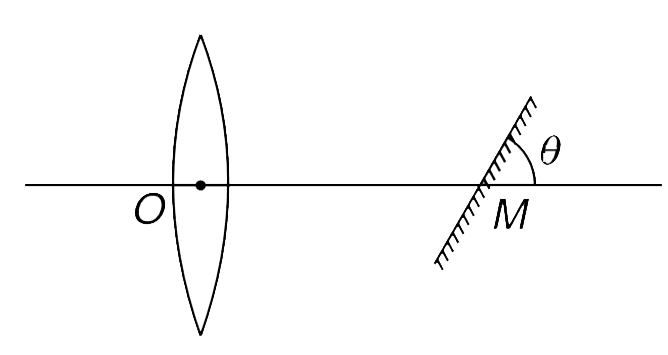A beam of light travelling parallel to the principal axis of a concave lens appears to diverge from a point 20 cm behind the lens after after passing through the lens. Find the power of the lens.
By definition, the point from where the bean appears to diverge is the focus of the lens. Thus, the focal length is 20 cm. As it is a concave f is negative.
f=−20cm=−0.2m.
The power is P=1f=1−0.2m=−5D.
Topper's Solved these Questions
Similar Questions
In the case of a convex lens, show the path of the refraction ray when the incident ray of light (1) is parallel to the principal axis of the lens (2) passes through the focus of the lens (3) passes through the optical centre of the lens.
View SolutionA parallel beam of light passes parallel to the principal axis and falls on one face of a thin convex lens offocal length f and after two internal reflections from the second face forms a real image. The distance of image from lens if the reflactive index of material of lens is 1.5 :
View Solution
Knowledge Check
A ray of light coming parallel to the principal axis after passing through a convex lens, passes through its
Aoptical centreBfocusCcentre of curvatureDnone of theseA ray of light passing through the principal focus of a convex lens after refraction
Apasses through the optic centre.Bemerges parallel to the principal axis.Cemerges without any deviation.DNone of theseAn object placed 10cm in front of a lens has an image 20cm behind the lens. What is the power of the lens( in diopters ) ?
A1.5B3.0C−15.0D+15.0
A horizontal parallel beam of light passes though a vertical convex lens of focal length 40 cm. Behind the lens there is a plane mirror making an angle θ with the principal axis of the lens. The mirror intersects the principal axis at M. Distance between the optical centre of the lens and point M is OM=20cm. The light beam reflected by the mirror converges at a point P. Distance OP is 20 cm. Find θ.

View SolutionA 2.0-cm-high object is placed 12 cm from a convex lens, perpendicular to its principal axis. The lens forms a real image, whose size is 1.5 cm. Find the power of the lens .
View SolutionA converging beam of light is incident on a concave lens. The beam converges behind the lens at 15 cm from its centre, in the absence of the lens. Select the correct alternative
View SolutionA converging beam of light is incident on a concave lens of focal length 20 cm. In the absence of the lens, the beam converges at a point 10 m behind the lens. Find where the beam will converge/diverge after refraction.
View SolutionA converging beam of light is incident on a concave lens. The beam converges behind the lens at 15 cm from its centre, in the absence of the lens. Select the correct alternative
View Solution
